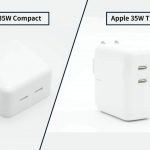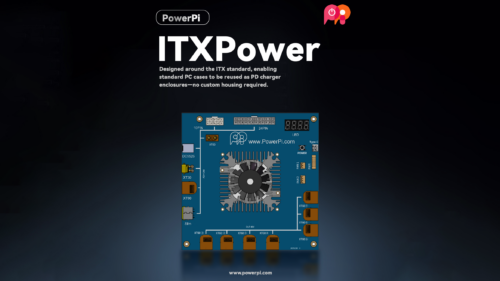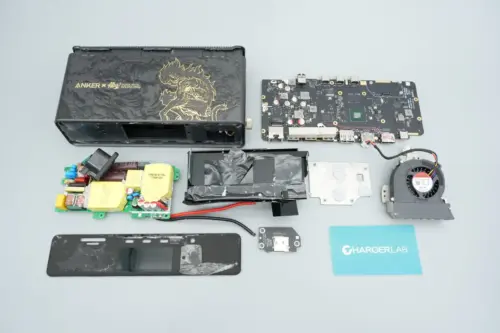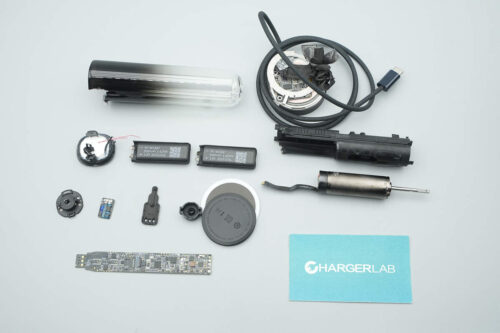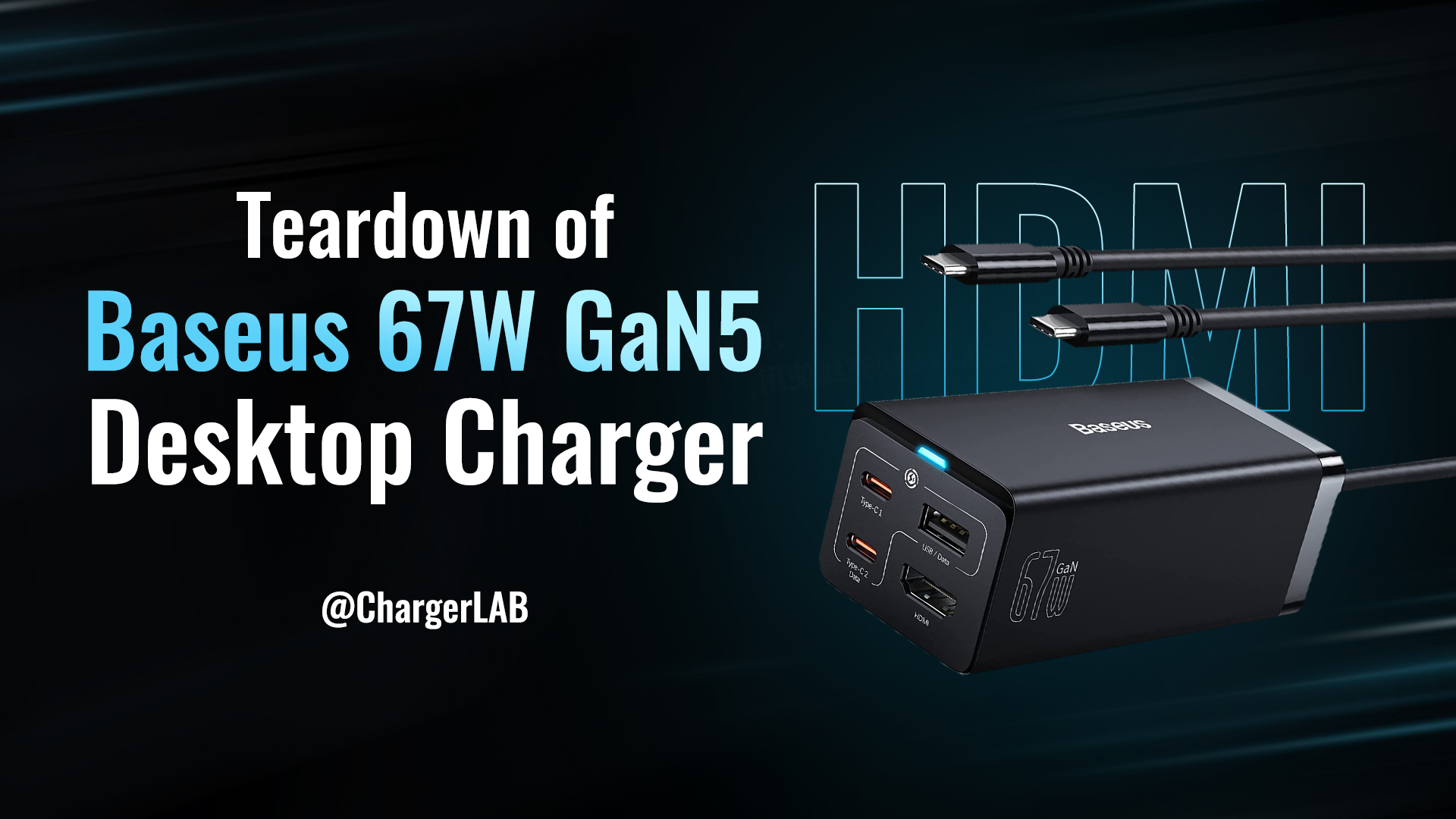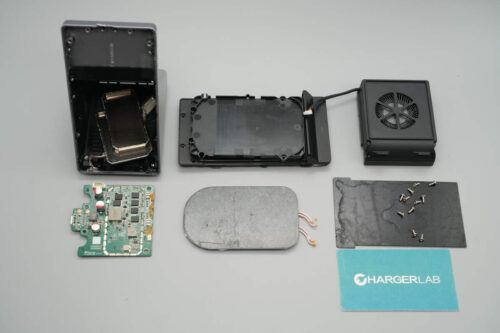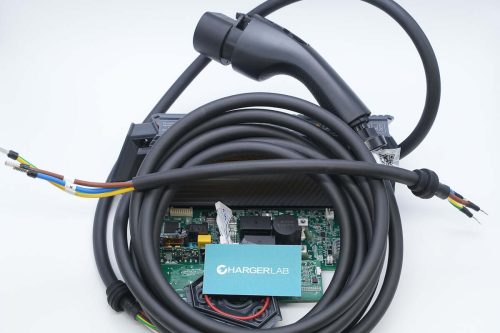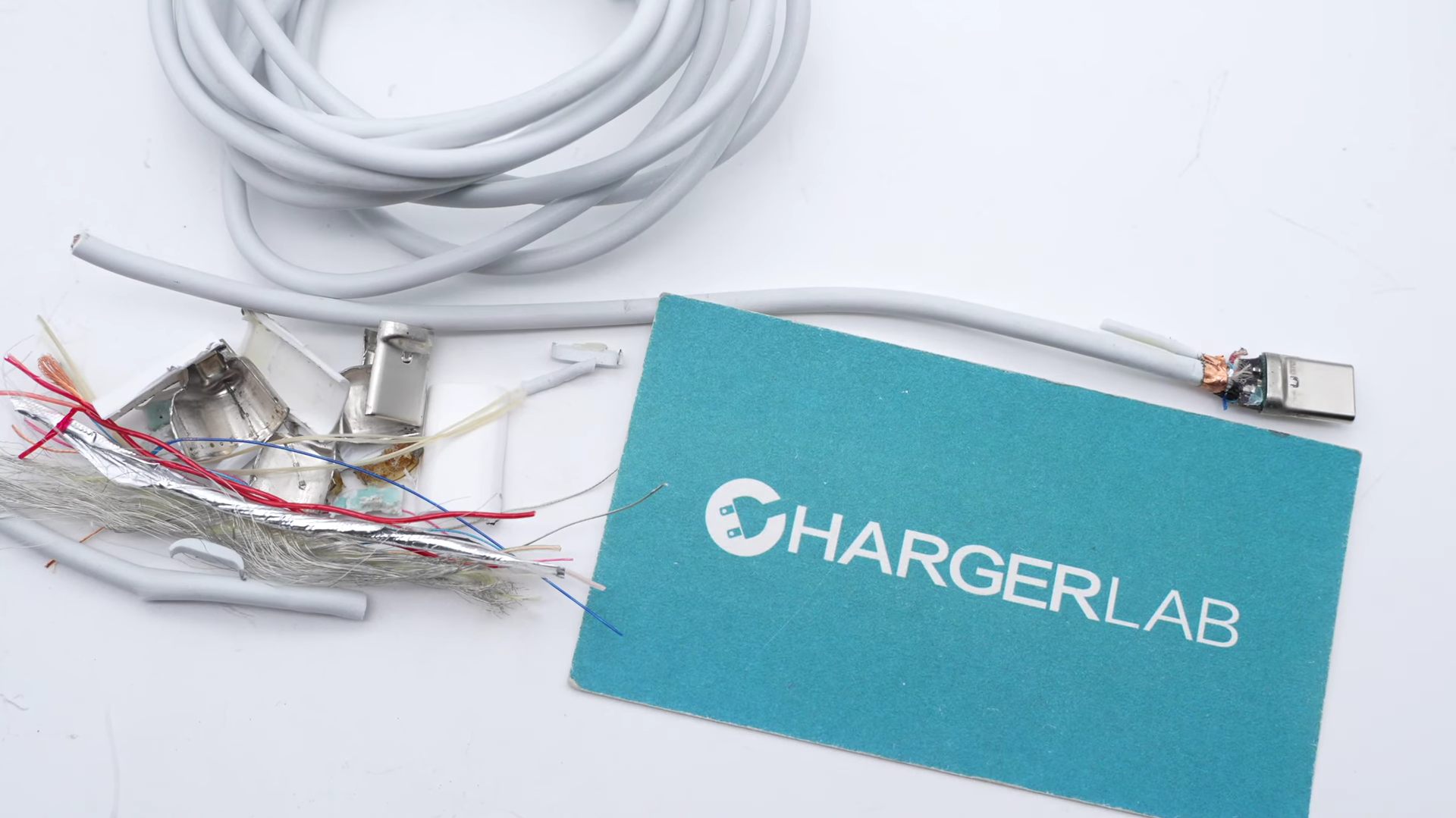Introduction
Recently, ChargerLAB took apart two Apple 35W chargers unveiled at WWDC22, the compact A2579 and traditional A2676, which have the same performance and dual USB-C ports. But their exterior design and interior components are completely different. So, ChargerLAB will have a teardown comparison of the two chargers to make it clear.
Appearance
Packaging

Except for the product, the packaging design is much the same.
Charger

The left charger adopts a new compact design, with a glossy white shell and flat grey bottom, which can fit well into the wall outlet or flat cable socket.
The right one is more traditional, with foldable prongs and a removable module.
Size / Power Density

The size of the compact charger is 49 x 49 x 28mm (1.92 x 1.92 x 1.1 inches), and the power density is about 0.51W/cm³.
The size of the traditional charger is 56 x 56 x 28mm (2.2 x 2.2 x 1.1 inches), and the power density is about 0.39W/cm³. As we can see, it's a little bit larger than the compact version.
Port

Both chargers are equipped with dual USB-C ports. But the arrangement is different, and there are circles of white plastic around the USB-C ports of the traditional one.
Specification

Here are the specifications of the two, respectively.
Model: A2579
Input: 100-240V 50/60HZ 1A
PD output 1 or 2: 5V3A, 9V3A, 15V2.33A, 20V1.75A
Manufacturer: Salcomp
Model: A2676
Input: 100-240V 50/60HZ 1A
PD output 1 or 2: 5V3A, 9V3A, 15V2.33A, 20V1.75A
Manufacturer: Flextronics Power
Both chargers share the same input and output specifications. But the manufacturers are different.
Weight

The weight of the compact charger is 104g (3.66oz), slightly lighter than the 116g (4.02oz) of the traditional one.
Inside
Front

The compact charger has two independent switching power supply circuits corresponding to two independent transformers and output filter capacitors. And the input is powered by a connector to meet Apple's design for multi-country prongs.
The PCBA module of the traditional charger can be divided into an AC-DC circuit and a secondary step-down circuit. The ground wire is fixed with screws, and the transformer is directly soldered to the small buck board. And the small buck board is synchronously rectified and filtered to supply power to the step-down circuit. In addition, a separate plastic shell is used for insulation.
Back

Just like the front of the compact charger, the synchronous rectifier, VBUS switch MOSFET, and other components on the back are symmetrical.
The traditional charger has bridge rectifiers and a primary switch MOSFET on the back.
Components
Primary Controller

Two master control chips of the compact charger are marked with ZN1431C, the customized models for Apple from PI. They integrate the primary controller, switch transistor, and synchronous rectification controller.
And the master control chip of the traditional charger is Apple’s customized model, marked with APSLCA01, which is also used in Apple 96W and 30W chargers.
Synchronous Rectifier Controller

The synchronous rectifier controller of the compact is integrated into the PI master control chip, and the traditional's is marked with TEV.
Protocol Chip

The protocol chips of these two chargers are the same, CYPD4236-LQXQT from the Infineon CCG4 series. But the right one is with white rubber reinforcement on edge.
The chip adopts a QFN 6*6mm package and integrates a 32-bit ARM M0 processor, 128KB flash memory, and 8KB memory. It also supports dual-port USB PD fast charging, which can be used for many devices.
Primary Switch Transistor

The primary switch transistor is integrated into the master control chip of the compact charger, while the traditional charger adopts AOS AONV180A60, an NMOS withstanding 700V and 160mΩ, with a DFN 8*8 package.
Synchronous Rectifier

The AOS AONS62920 synchronous rectifier on the left adopts the DFN5*6 package and 100V, 6.3mΩ.
The Infineon BSC093N15NS5 synchronous rectifier on the right adopts the SuperSO8 package and 150V, 9.3mΩ.
Capacitor

The compact charger has three primary electrolytic capacitors. Two are from AiSHi, 400V 22μF, and the third is from CapXon, 10μF 400V.
And three electrolytic capacitors of the traditional charger are from CapXon, 22μF 400V.

Then, the compact charger also has two CapXon solid capacitors used for output filtering, 560μF 25V.
The traditional charger only has a Nichicon solid capacitor, 270μF 25V.
Synchronous Step-down Controller

Compared to the compact charger, the traditional charger has two synchronous step-down circuits. So, it's equipped with the synchronous step-down controller from MPS MP9928 and used for step-down control of two USB-C ports, respectively. It integrates the half-bridge NMOS driver and supports the programmable operating frequency. It also has output overvoltage and overheat protection.
Synchronous Step-down Switch Tube

The step-down PCB is also equipped with synchronous step-down MOSFET from ON Semiconductor, which integrates dual MOSFETs for each, 30V, 6.4-11.6mΩ.
Performance
Protocol


The ChargerLAB POWER-Z KT002 shows both USB-C ports of the two chargers support the same protocols of Apple 2.4A, Samsung 5V2A, DCP and PD3.0.
PDO


Both USB-C ports of the two chargers support the same four fixed PDOs of 5V3A / 9V3A / 15V2.33A / 20V1.75A. Either USB-C1/C2 can support up to 35W output with an intelligent distribution.
Summary of ChargerLAB

We made a chart for you to compare the differences between those two chargers.
They have many similarities and also many differences. We can only see the difference in appearance from the outside because they have the same power, same USB-C ports, and even the same performance. But if we dig a little deeper, we'll see they're completely different.
The compact charger adopts two switching power supply circuits, while the PCBA module of the traditional charger can be divided into an AC-DC circuit and a secondary step-down circuit.
Since they're the same price, it's up to you to choose the most suitable one.
Related Articles:
1. What's Difference Between Two Apple 35W Charger (Compact and Traditional)
2. Same but Different | Teardown of Apple 35W Dual USB-C Traditional Power Adapter
3. Completely Different | Teardown of Apple 35W Dual USB-C Compact Power Adapter

